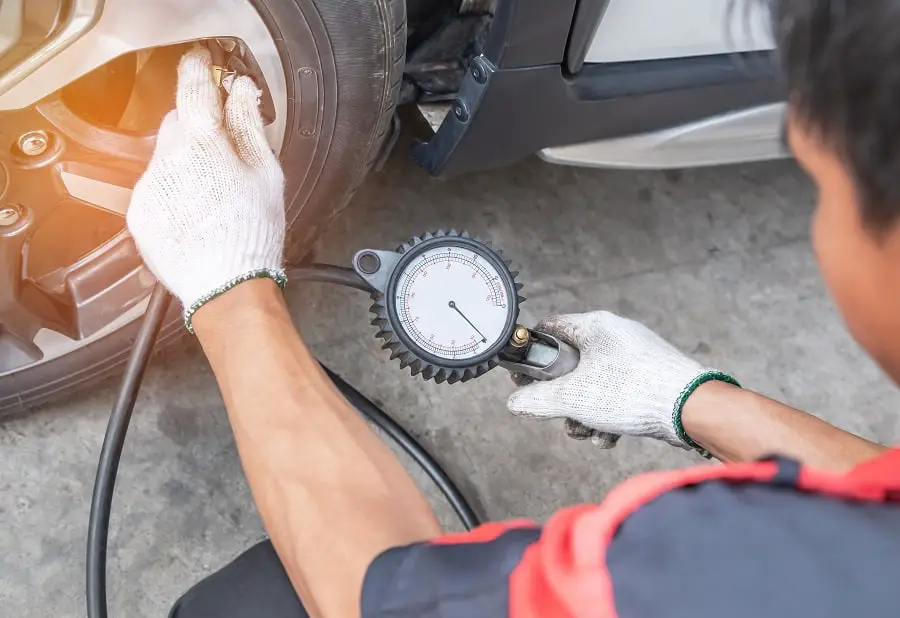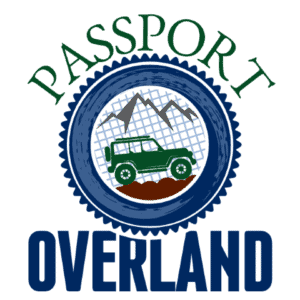
Driving on gravel roads, muddy trails, sand, and wet roads is the most challenging yet fun part of overlanding. Off-roading is where you experience the adrenaline rush and makes you feel like living again. But you can’t have this kind of experience without the right tire pressure in your vehicle.
Normal tire pressure only works on paved roads. In off-road driving, this tire pressure can damage your vehicle, your tires, and worse, can lead to unwanted road accidents. So keep in mind to always air down when you drive off-road.
Best Tire Pressures for Off-Roading
The PSI (pounds per square inch) measures the air pressure inside your tires. The manufacturer provides the best-suited PSI for your vehicle, but if you don’t know it, you can go with the general rule.
The recommended PSI for daily driving is between 30 and 35, and this only works on smooth road surfaces. For comfortable and safe off-road driving, you need to reduce this air pressure by 25%, somewhere between 15-20 PSI.
| ROAD/ OFF-ROAD CONDITION | BEST AIR PRESSURE |
| Dry Paved Road | 30-35 PSI (manufacturer recommended tire pressure) |
| Gravel/ Dirt Roads | 25-30 PSI |
| Rocky Terrain | 20-25 PSI |
| Sandy Land | 15-20 PSI |
| Muddy Terrain (We love mud!) | 15-20 PSI |
| Summer (hot weather) | 30-35 PSI (remember air pressure increases 1 deg F every 10 degrees F increase) |
| Winter (cold weather) | 30-35 PSI (remember air pressure decreases 1 deg F every 10 deg F decrease) |
For newbie overlanders, the world of 4×4 can be a little bit overwhelming with all the necessary gear and upgrades. What is the best air pressure for off-road tires?
How do I upgrade the tires on my truck for improved traction? Don’t worry, for these questions will all be answered in this article. Consider this your beginner’s handbook for off-road tire pressure.
How to Deflate Tires
This way, you increase your tire’s length or footprint for a better grip or contact with the road surface. To put it simply, you make your tires flexible enough to pass through rough terrain so they won’t sink or burst. But how do you do this? You release air from your tires either using the traditional method and a PSI gauge or a deflator device.
Using a Flat-head Screwdriver and a PSI Gauge
To let air out of your tire, you can use a flat-head screwdriver or any object that is thin and small. Locate the valve on your tire and remove its cap by rotating counterclockwise. Check the pressure on your tire using a PSI gauge like the RHINOUSA Heavy-Duty Tire Presssure Gauge so you can estimate how much air you need to release. Then, press the thin metal pin inside the valve using the flat-head screwdriver to release air. Use the gauge to know whether you’ve reached your target PSI yet or not.
Using a Tire Deflator
Using the manual or traditional method is a trial and error game. You release air, and then you measure the PSI to know if you’ve reached your ideal tire pressure. If not yet, you press the metal pin inside the valve until you achieve it. To save time and energy, you can just use a tire deflator like the ARB E-Z DEFLATOR.
Tire Pressure for All Terrains
Although the recommended PSI for off-road driving is somewhere between 15-20, the terrain you’ll encounter and have to conquer varies a lot. At some point in time, you’ll find yourself in the middle of nowhere with mud or sand that you have to pass through. Expect to drive more on dirt roads and less on highways because this will be your life during your overlanding trip. Let’s enumerate all the terrain that you will definitely encounter and what PSI is best recommended for each of them.
Gravel/Dirt Roads
Most likely, dirt roads will be your home during your entire adventure trip. This is also the “normal” for off-roaders. The moment you reach the end of the highway and see a road with a combination of earth and gravel ahead of you, it’s time to air down. Stop your vehicle and assess the dirt road.
Step on the earth and feel if it can carry the weight of your vehicle. Check the pebbles or stones if they have the potential to damage your tires. If it’s a smooth dirt road, then you can drive on it without changing the PSI of your tires. If it’s a rough dirt road with a combination of gravel and earth, then you might want to consider airing down because the small pebbles can cause a bumpy ride and tire blowouts.
The general rule for airing down is to reduce air pressure by 5 PSI, depending on the road conditions. So, if you are running on a highway with a 30 PSI tire pressure, you can air down to 25 PSI to be able to drive on a gravel road. The best tire pressure for dirt roads is 25-30 PSI. The only way to find out if a specific PSI is the right pressure is to test it. If you can handle your vehicle with ease and your passengers are comfortable enough, then you can proceed with that PSI.
Rocky Terrain
Driving on rocks is a bit challenging because the road surface is not flat and the sharp edges of rocks can even cut your tires. You need to air down so you let the tires conform to the rocky surface and not react against it. You can reduce the air pressure in your tires to 20 PSI. The best tire pressure for dirt roads is 20-25 PSI. You have to keep in mind that as you lower your tire pressure, you also have to reduce your speed. Driving fast on a low PSI can deflate your tires faster. If you reduce your tire pressure by 25%, you have to reduce your speed by 25% also.
Sandy Land
If the road surface you have to deal with is sand, you can reduce tire pressure by up to 10 PSI, depending on how soft the sand is. Reducing tire pressure makes your vehicle float over the surface and not get buried in the sand. The two sandy driving conditions you will likely encounter in your off-road driving are at the beach and in the desert. The best tire pressure for driving in soft sand is 15-20 PSI. However, sand in the desert and sand on the beach are two different things. You have to adjust the tire pressure accordingly.
- Beach Sand: The sand on the beach is coarse and damp, and can more likely support the weight of your vehicle. You can drop the tire pressure to 20 PSI.
- Desert Sand: The sand here is dry and fine. To avoid sinking, you can lower the tire pressure to 16 PSI.
Mud, We All Love Mud
Nothing can beat the thrill of driving on a muddy road with the splashing of mud everywhere. The presence of mud in everyone’s vehicle is both bragging rights and evidence of the fun adventure. To enjoy the muddy road, you can lower the tire pressure to 15 PSI if the mud seems too deep and bottomless. If the road is muddy but has a firm base underneath, it can support your vehicle. In this case, you don’t have to lower tire pressure much. The Best Tire Pressure for Muddy Roads is 15-20 PSI.
Tire Pressure for Other Types of Driving Conditions
Summer
Summer is the best time for overlanding, but the extremely hot temperature can affect almost everything in your vehicle. Tire pressure reacts to changes in temperature. Tire Pressure rises by 1 PSI for every 10 deg Fahrenheit increase in temperature. So, keep in mind to not overinflate and set the tire pressure to 30-35 PSI.
Winter
If you plan to seek adventure in a faraway land like Alaska and witness the beauty of the Northern Lights, the snow will be your life. Your tires should win over the cold, wet, slippery, and snow-covered roads. In this case, you can maintain your normal tire pressure of 30-35 PSI. You don’t have to air down. In fact, in cold weather, you have to inflate because cold weather conditions drain tire pressure easily. Your tire pressure drops by 1 PSI for every 10 deg Fahrenheit drop in temperature.
Best Tires for Overlanding
Airing down helps prolong the life of your vehicle’s suspension by reducing the stress it receives from challenging terrain. But too much or frequent airing down is an abuse that not all tires can handle. If you want to make driving on different terrain easier without frequently adjusting your tire pressure, you can just upgrade your tires. Here are some tires to choose from.
BF Goodrich
If you’re looking for a brand that has a good reputation and experience in making off-road tires, then you can go with BF Goodrich. Their original Mud-Terrain T/A was first introduced to the market in 1980, and up until now, they have worked hard to innovate tires for off-roading.
For All-Terrain: BFG KO2
Mickey Thompson Performance Tires
Mickey Thompson was an automotive pioneer. He designed tires according to his experience in off-road racing. His company started in 1963 and released its first off-road tires in 1977, which was the On/Off-Road Tire with Tread and Sidewalls.
For All-Terrain: Baja ATZ P3
Goodyear
Heritage, innovation, and technology. Goodyear is best known for its affordable and high-quality tires. They have been supplying tires since 1898 for industrial operations, airlines, etc. It is one of the largest tire manufacturers in the world, with 50 plants in 22 countries.
For an improved puncture resistance of 35%: Wrangler MTR with Kevlar
What Is The Best Air Pressure For Off Road Tires?
Notice that there is no specific PSI for specific terrain; it’s all in a range. That is because when adjusting tire pressure, there are many things to consider, like your tires, the load of your vehicle, and the terrain, so it really varies a lot. The best air pressure for off-road conditions is 15-20 PSI, which is also the recommended starting point in off-road driving.

